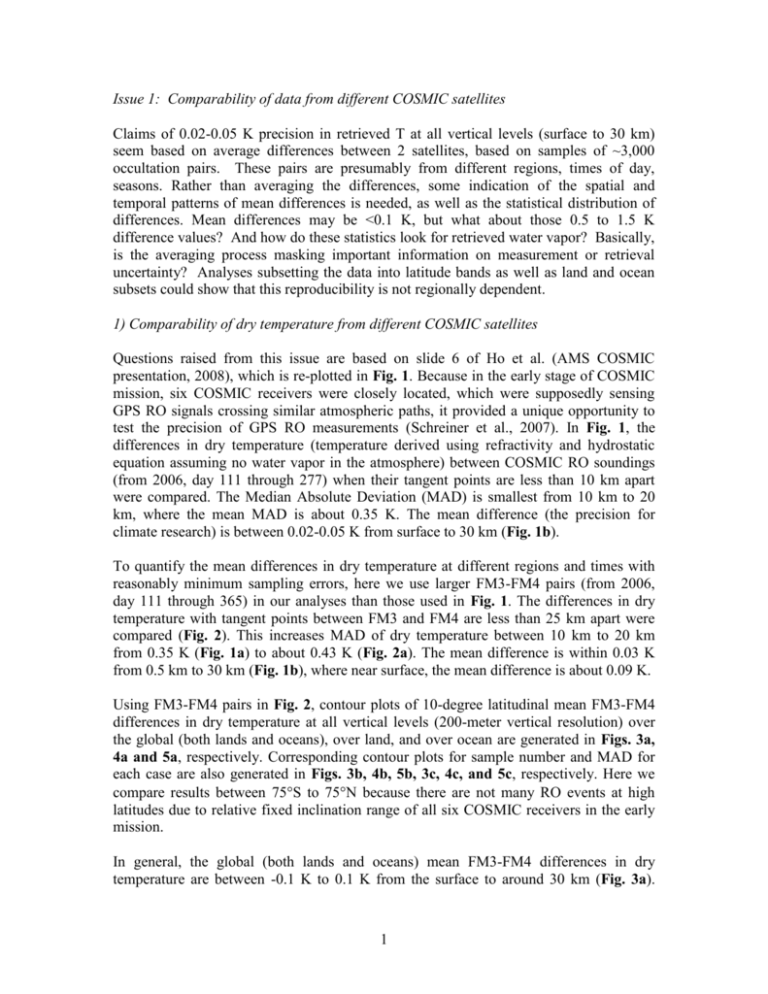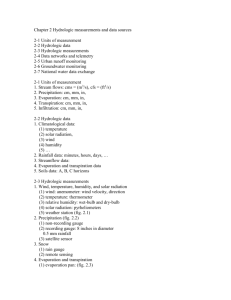Issue 1: Comparability of data from different COSMIC satellites
advertisement

Issue 1: Comparability of data from different COSMIC satellites Claims of 0.02-0.05 K precision in retrieved T at all vertical levels (surface to 30 km) seem based on average differences between 2 satellites, based on samples of ~3,000 occultation pairs. These pairs are presumably from different regions, times of day, seasons. Rather than averaging the differences, some indication of the spatial and temporal patterns of mean differences is needed, as well as the statistical distribution of differences. Mean differences may be <0.1 K, but what about those 0.5 to 1.5 K difference values? And how do these statistics look for retrieved water vapor? Basically, is the averaging process masking important information on measurement or retrieval uncertainty? Analyses subsetting the data into latitude bands as well as land and ocean subsets could show that this reproducibility is not regionally dependent. 1) Comparability of dry temperature from different COSMIC satellites Questions raised from this issue are based on slide 6 of Ho et al. (AMS COSMIC presentation, 2008), which is re-plotted in Fig. 1. Because in the early stage of COSMIC mission, six COSMIC receivers were closely located, which were supposedly sensing GPS RO signals crossing similar atmospheric paths, it provided a unique opportunity to test the precision of GPS RO measurements (Schreiner et al., 2007). In Fig. 1, the differences in dry temperature (temperature derived using refractivity and hydrostatic equation assuming no water vapor in the atmosphere) between COSMIC RO soundings (from 2006, day 111 through 277) when their tangent points are less than 10 km apart were compared. The Median Absolute Deviation (MAD) is smallest from 10 km to 20 km, where the mean MAD is about 0.35 K. The mean difference (the precision for climate research) is between 0.02-0.05 K from surface to 30 km (Fig. 1b). To quantify the mean differences in dry temperature at different regions and times with reasonably minimum sampling errors, here we use larger FM3-FM4 pairs (from 2006, day 111 through 365) in our analyses than those used in Fig. 1. The differences in dry temperature with tangent points between FM3 and FM4 are less than 25 km apart were compared (Fig. 2). This increases MAD of dry temperature between 10 km to 20 km from 0.35 K (Fig. 1a) to about 0.43 K (Fig. 2a). The mean difference is within 0.03 K from 0.5 km to 30 km (Fig. 1b), where near surface, the mean difference is about 0.09 K. Using FM3-FM4 pairs in Fig. 2, contour plots of 10-degree latitudinal mean FM3-FM4 differences in dry temperature at all vertical levels (200-meter vertical resolution) over the global (both lands and oceans), over land, and over ocean are generated in Figs. 3a, 4a and 5a, respectively. Corresponding contour plots for sample number and MAD for each case are also generated in Figs. 3b, 4b, 5b, 3c, 4c, and 5c, respectively. Here we compare results between 75S to 75N because there are not many RO events at high latitudes due to relative fixed inclination range of all six COSMIC receivers in the early mission. In general, the global (both lands and oceans) mean FM3-FM4 differences in dry temperature are between -0.1 K to 0.1 K from the surface to around 30 km (Fig. 3a). 1 Relative large mean differences (~0.3 K) are found near tropical regions below 3 km and above 25 km and between 60S to 80S above 25 km, which may be primarily due to much smaller samples used (Fig. 3b) and larger MAD over these regions (Fig. 3c). Larger MAD below 8 km is related to larger natural variability (especially for water vapor) within 25 km separation distance. The increase of MAD above 25 km is most likely caused by the residual errors of the ionospheric calibration, which is consistent with the MAD found in Fig. 2a. Unlike nadir viewing microwave and infrared instruments, whose measurement sensitivity to the derived variables usually varies significantly over different surface types due to different thermal contrast (difference between surface skin temperature and surface air temperature), the quality of GPS RO signals (precision) are relatively independent to surface conditions. Fig. 4 depicts the contour of the mean FM3-FM4 differences in dry temperature over lands. Over 40N to 70N region and 65S to 70S region, the mean FM3-FM4 dry temperature differences are between -0.1 K to 0.1 K from the surface to around 30 km (Fig. 4a). Larger dry temperature biases are in tropical regions below 5 km where only less than 50 sample pairs are available (Fig. 4b). This is consistent with mean FM3-FM4 dry temperature differences over oceans (Fig. 5). In the 40S to 60S region, where we have more FM3-FM4 pairs (Fig. 5b), the mean FM3-FM4 dry temperature difference is also between -0.1 K to 0.1 K (Fig. 5a). To demonstrate the consistency of the precision of GPS RO signals, we further generate the contour plot for the mean FM3-FM4 dry temperature differences with different local times (Fig. 6). The mean FM3-FM4 dry temperature differences are all within 0.08 K from surface to around 30 km (Fig. 6a), except for regions for 2300 local time near 28 km and regions near the surface, For the later case, the larger mean FM3-FM4 dry temperature differences are more likely related to much small sample pairs used (less than 150 pairs, Fig. 6b) and larger natural variability (Fig. 6c) than above. Figs. 3-6 demonstrate the temporal and spatial comparability of dry temperature from COSMIC FM3 and FM4 satellites where we have more FM3-FM4 pairs than other pair combination. In my responses to issues 2, dry temperature profiles from each COSMIC receiver are compared to those of CHAMP separately. Those results shall indirectly indicate the comparability of dry temperature from different COSMIC receivers (see Figures for Issue 2 response). 2) Comparability of water vapor from different COSMIC satellites GPS RO water vapor (wv) is derived using 1D-var algorithm, which, using ECMWF temperature and water vapor profiles as initial conditions, optimally separates refractivity profiles into temperature and moisture profiles. With less than 25 km and 10 minutes apart, the same ECMWF temperature profiles shall be used for the collocated FM3 and FM4 pairs. The global mean FM3-FM4 water vapor differences are in Fig. 7. 2 The MAD (in blue line) is about 0.4 g/kg (Fig. 7a) near the surface then decreasing with height. The mean difference is less than 0.025 g/kg from the surface around 8 km (Fig. 7b). Similar to Figs. 2-6, we use FM3-FM4 WV pairs in Fig. 7 to generate contour plots of 10-degree latitudinal mean FM3-FM4 differences in water vapor at all vertical levels (200-meter vertical resolution) over the global (both land and ocean), over land, and over ocean in Figs. 8a, 9a and 10a, respectively. Corresponding contour plots for sample number and MAD for Figs. 8a, 9a and 10a are also generated in Figs. 8b, 9b, 10b, 8c, 9c, and 10c, respectively. Again, only results between 75S to 75N are generated. The global mean FM3-FM4 water vapor differences are between -0.1 to 0.1 g/kg from the surface to 8 km (Fig. 8a). The magnitude WV MAD between FM3 and FM4 depends on two factors. One is the sensitivity of WV to refractivity (N), another is the natural variability of N. For regions with high moisture, the sensitivity of WV to refractivity is stronger but the N uncertainty due to water vapor variation is also larger than other regions. But over mid-lat, the sensitivity of WV to refractivity may be weaker (than that over tropics) but the uncertainty of N to WV variation may be not smaller than those over Topics especially near PBL. Over cold polar regions, the sensitivity of WV to refractivity may be weakest among all regions, but N uncertainty due to water vapor is also smallest among all regions. This may lead to higher water vapor MAD mid- and high-latitudes (Fig. 8c) than that over the Tropics. More investigations will be followed in the near future. The mean FM3-FM4 water vapor differences are between -0.1 to 0.1 g/kg from the surface to 8 km over lands (Fig. 9) and over oceans (Fig. 10) and at all local times (Fig. 11) except for some regions below 2 km. 3








